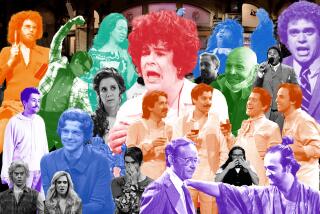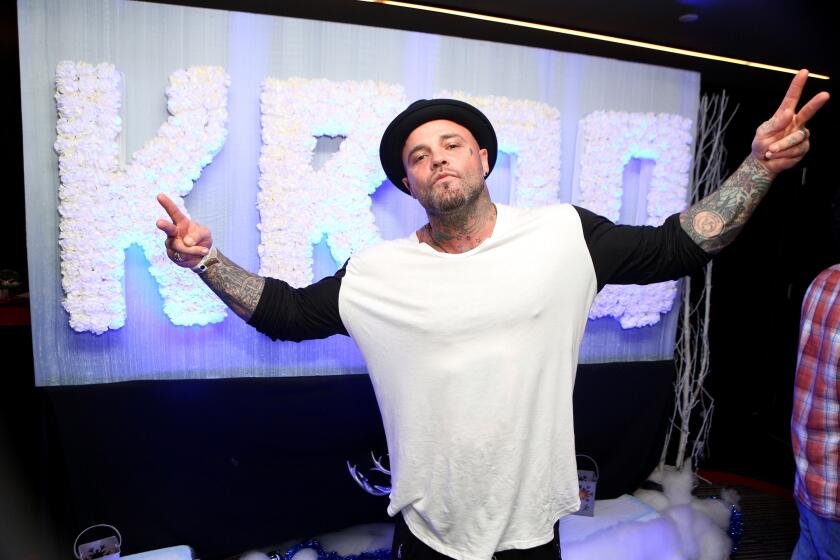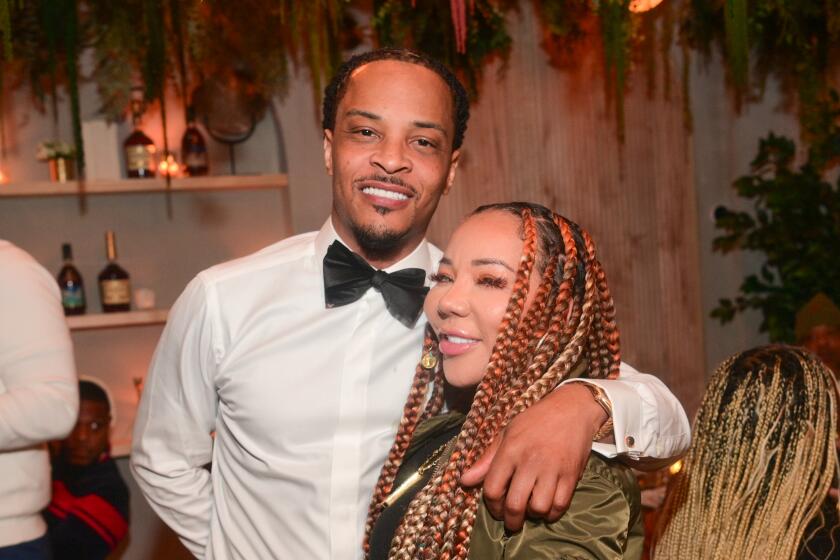How LCD Soundsystem became the cool elder statesmen of dance music
The marquee atop the Fox Theater in Pomona didn’t exactly advertise the fact that one of the biggest pre-Coachella reunion concerts in years was afoot.
“NOTHING TO SEE HERE,” the sign read on Monday night, gently needling the hundreds and hundreds of people queued up to see LCD Soundsystem’s first show in Southern California in more than five years. The line wound around almost an entire city block, just about lapping back to the Fox’s ticket counter.
Coachella 2016: Live coverage of the bands, the fashion, the scene
There, the hopped-up LCD fans got another cheeky command from above.
“KEEP MOVING.”
James Murphy’s modern disco band (maybe not the perfect descriptor, but one he’d likely be OK with) has stood nearly alone through seismic shifts in American dance music the last 15 years.
In a scene obsessed with youth and escapism, he’s a perma-stubbled 46-year-old whose 2002 debut single was an exhausted complaint about being too old to keep up with the kids (who are all light-years less catch-up-able now). As CDJs and retina-scarring lighting became the default tools of festival dance music, Murphy assembled a live band more akin to Nile Rodgers’ Chic — a party band steeped in DJ culture but brimming with spontaneity and charisma.
But most of all, in a genre that makes its points through the promise of the new, Murphy wrote songs like “All My Friends” that are already classic rock for millennial clubbers. Though a five-year absence may seem paltry compared with the decades fans have waited for fellow Coachella headliner Guns N’ Roses to return, it’s a lifetime in today’s dance music. Maybe it’s just enough time for the band to feel new again.
Outside the Pomona show on Monday, LCD’s return seemed no less electric for being somewhat expected.
“I’m really excited. I think there was always an expectation that they’d come back. The fan base has stayed really loyal — you see how many people showed up for this,” said Cecilia Shakerley, who drove out from L.A. for the Pomona show.
“We were in line at 7 a.m. at Amoeba to buy tickets when they announced it,” said Bernie Schaefer, also from L.A. “We saw people who had been out there since 2 a.m.... I’m just so glad they’re doing this now because they have something new to say, and not doing it 15 years later because they needed the money or something.”
In the five years since the band’s emotional retirement party at Madison Square Garden (amply documented in a documentary film, quintuple-LP live album and tens of thousands of rended garments from millennial clubgoers), dance music has changed immeasurably. But LCD’s influence has been most impressive because no one’s tried to copy it.
For newer Coachella dance music artists, who were children when “Losing My Edge” dropped and were teenagers when LCD broke up, the band has a kind of lore. “It was really hard to not like them,” said the young L.A. producer Ghastly, who is playing the festival’s DoLab tent. “ ‘Daft Punk Is Playing at My House’ sparked a lot of ambition in my songwriting because of its utter carelessness for what is considered hip or popular, and created its own story.”
Thomas Jack, the Australian producer and Coachella performer who helped establish the current “tropical house” sound that’s omnipresent at festivals and pop radio, noted that “LCD Soundsystem played a huge role in changing the modern festival landscape in terms of underground dance culture.
“Their sound introduced indie and rock fans to dance grooves that they would not have heard otherwise — or at least didn’t know they liked. They were the very ethos of DJ culture, by using their own tastes to create genre-bending sets of music, but they were a fully formed band with a fully formed vision. How common is that? Not very.”
Murphy kept more or less busy in the interim — frequent DJ tours, a wine bar, an endearingly futile plan to make the New York City subway turnstiles play harmonic notes upon entry. LCD Soundsystem reportedly will have a new LP, the band’s fourth, out later this year. But while the last five years have been great for smart, meaningful club music ascending at major U.S. festivals, it’s becoming clear that LCD has had an arguably deeper influence than just opening up a genre.
The first Coachella had plenty of acts — Underworld, Juan Atkins, Chemical Brothers — who were foundational to English rave and American techno. A decade into electronic dance music’s ascent, Calvin Harris can play the main stages to some of the biggest crowds Coachella’s seen.
But LCD (which is essentially Murphy with about half a dozen regular collaborators) was one of the first acts to lead novice audiences into the dance tents for something new. There’s never really been a band that can straddle Coachella’s current divide between classic-rock revivalism, the Sahara tent’s ecstatic raves and the newer Yuma tent’s heavy body music at once, all while playing with the force of a headliner (the band closes out both Friday nights at the festival).
“The sound design in LCD Soundsystem is incredible and their players are some of the best in the world. I feel there is a level of difficulty to putting on a live show like this that a lot of DJs aren’t able to match,” said Nina Las Vegas, an artist and DJ at the taste-making Australian radio station Triple J, who is playing the festival.
Even though it’s been only half a decade, LCD’s return comes with some pangs of lost time. For club-music fans who hauled out to big cities in the mid 2000s and are feeling the pains of fading youth, Murphy is kind of a late-night Bruce Springsteen. The shows are raucous, and Murphy’s self-aware wit is smart and inclusive. But there’s always an undercurrent in his songs about watching your life decisions add up and your future slowly winnowing down. That’s what makes the escape of the party all the more necessary.
Murphy “has a sense of humor that works so well. The 2000s were a sarcastic time, but he coupled that with a real angst about, ‘What are we all doing here?’” said Eli Goldstein, a producer and DJ in the veteran house group Soul Clap, which is also performing at Coachella.
“When people go to party, they go to escape. But all the most classic dance songs have some kind of message. It’s important to give people something to really feel as well.”
The feelings go both ways. Murphy acknowledged that he was taken aback by some negative reactions to LCD’s reunion. Five years is forever in club music, but for a Coachella headliner, that’s just a breather, after what was ostensibly a career-ending show. “There are people who don’t hate us at all, in fact who feel very attached to the band, and have put a lot of themselves into their care of us, who feel betrayed by us coming back and playing. Who had traveled for or tried to go to the MSG show, and who found it to be an important moment for them, which now to them feels cheapened,” he posted in January, announcing the band’s return.
“I was so clearly expecting the cynical cries of foul, that I hadn’t seen the heartfelt complaint coming.”
He vowed that those sentiments made it all the more necessary to not just come back, but to have something vital and new to offer. “It needs to be better than anything we’ve done before, in my mind, because it won’t have the help of being the first time.”
Despite whatever the marquees tell you, when he takes the Coachella main stage on Friday, it will definitely be something to see.
MORE COACHELLA:
First they were JJAMZ. Now they’re back to square one with Phases
They’re baaack: Coachella reunions of N.W.A and GNR promise a flashback to the angry ‘80s in L.A.
10 Coachella acts to catch beyond the headliners: Chris Stapleton, Kamasi Washington, Lush and more
More to Read
The biggest entertainment stories
Get our big stories about Hollywood, film, television, music, arts, culture and more right in your inbox as soon as they publish.
You may occasionally receive promotional content from the Los Angeles Times.











